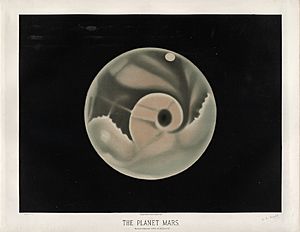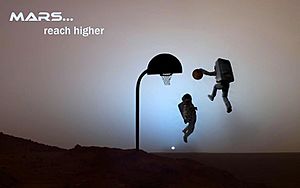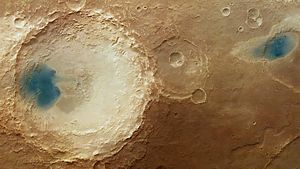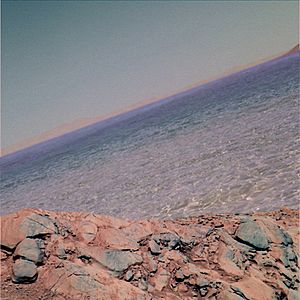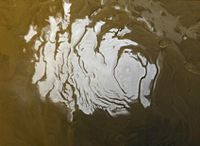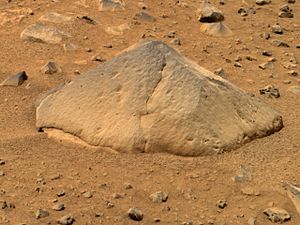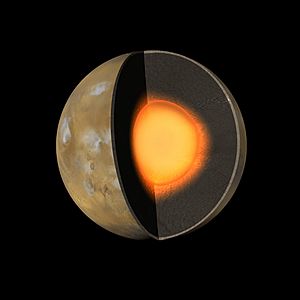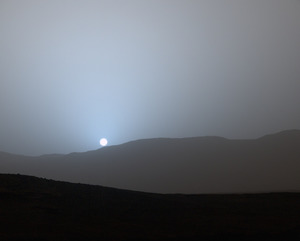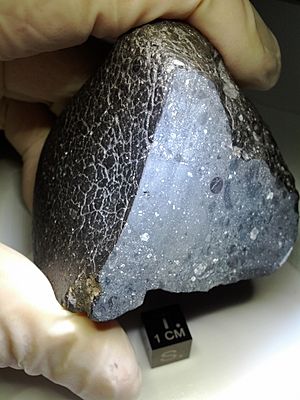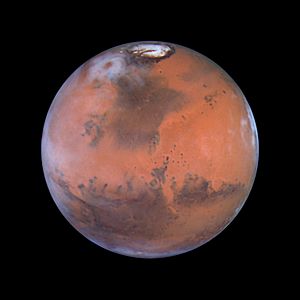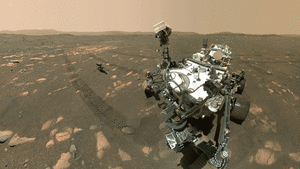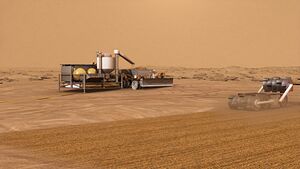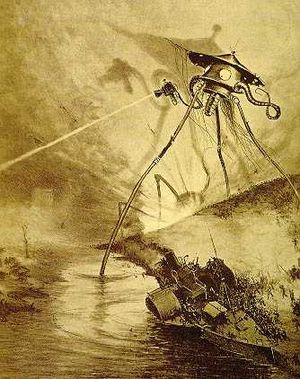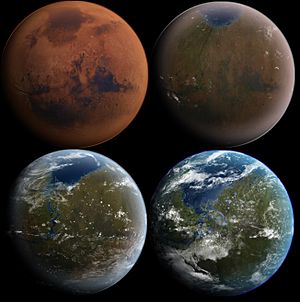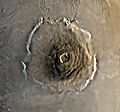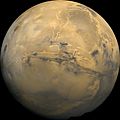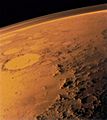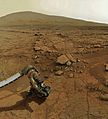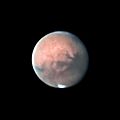Mars facts for kids
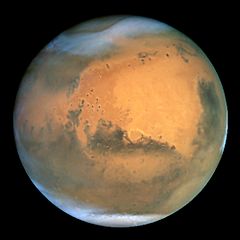
Mars as seen by the Hubble Space Telescope
|
|||||||||||||
| Designations | |||||||||||||
|---|---|---|---|---|---|---|---|---|---|---|---|---|---|
| Adjectives | Martian | ||||||||||||
| Orbital characteristics | |||||||||||||
| Epoch J2000 | |||||||||||||
| Aphelion | 249,209,300 km 1.665 861 AU |
||||||||||||
| Perihelion | 206,669,000 km 1.381 497 AU |
||||||||||||
| 227,939,100 km 1.523 679 AU |
|||||||||||||
| Eccentricity | 0.093 315 | ||||||||||||
| 686.971 days 1.8808 Earth years |
|||||||||||||
| 779.96 day 2.135 Julian years |
|||||||||||||
|
Average orbital speed
|
24.077 km/s | ||||||||||||
| Inclination | 1.850° to ecliptic 5.65° to Sun's equator 1.67° to invariable plane |
||||||||||||
| 49.562° | |||||||||||||
| 286.537° | |||||||||||||
| Known satellites | 2 | ||||||||||||
| Physical characteristics | |||||||||||||
|
Mean radius
|
3,389.5±0.2 km | ||||||||||||
| Flattening | 0.005 89 ± 0.000 15 | ||||||||||||
| 144,798,500 km² 0.284 Earths |
|||||||||||||
| Volume | 1.6318×1011 km³ 0.151 Earths |
||||||||||||
| Mass | 6.4185×1023 kg 0.107 Earths |
||||||||||||
|
Mean density
|
3.934 g/cm³ | ||||||||||||
| 5.027 km/s | |||||||||||||
|
Sidereal rotation period
|
1.025 957 day 24.622 96 h |
||||||||||||
|
Equatorial rotation velocity
|
868.22 km/h (241.17 m/s) | ||||||||||||
| 25.19° | |||||||||||||
|
North pole right ascension
|
21 h 10 min 44 s 317.681 43° |
||||||||||||
|
North pole declination
|
52.886 50° | ||||||||||||
| Albedo | 0.15 (geometric) or 0.25 (bond) | ||||||||||||
|
|||||||||||||
| +1.8 to −2.91 (brightness in the sky) | |||||||||||||
| 3.5—25.1" | |||||||||||||
| Atmosphere | |||||||||||||
|
Surface pressure
|
0.6–1.0 kPa | ||||||||||||
| Composition by volume | 95.72% Carbon dioxide 2.7% Nitrogen |
||||||||||||
Mars is the fourth planet from the Sun. It is the second smallest planet in our Solar System, only bigger than Mercury. In English, Mars is named after the Roman god of war. People often call it the "Red Planet" because its surface is covered in reddish iron oxide, which is like rust. This gives Mars a unique reddish look that you can easily see from Earth.
Mars is a terrestrial planet, meaning it has a rocky surface like Earth. It has a very thin atmosphere. Its surface has features similar to the impact craters on the Moon, and also valleys, deserts, and polar ice caps like Earth. Mars has two small, oddly shaped moons called Phobos and Deimos.
Mars is almost 7,000 kilometres (4,300 mi) wide, which is a little more than half the width of Earth. Its total size is about 15% of Earth's volume. Since a lot of Earth is covered by water, the land area on Mars is almost as big as all the land on Earth. Because of its size, it might be a good place for humans to build colonies one day.
Contents
Studying Mars Through History
People have been watching and recording Mars for a very long time. The first records come from ancient Egyptian astronomers over 3,000 years ago.
Babylonian astronomers made detailed notes about Mars's location. They even used math to predict where the planet would be in the future. Ancient Greek philosophers and astronomers thought Earth was the center of the solar system. They used this idea to explain how planets moved. Later, astronomers in India and Islamic countries estimated Mars's size and how far it was from Earth. Chinese astronomers also did similar work.
In the 1500s, Nicholas Copernicus suggested a new idea. He said that planets orbit the Sun in circles. This "heliocentric" model (Sun-centered) was the start of modern astronomy. Later, Johannes Kepler improved this idea. He showed that Mars actually moves in an oval-shaped path, which fit the observations better.
The first time someone looked at Mars through a telescope was in 1610 by Galileo Galilei. Within 100 years, astronomers noticed bright and dark spots on Mars, including its polar ice caps. They figured out how long a Martian day was (its rotation period) and how much it was tilted (axial tilt). Better telescopes in the 1800s allowed them to map Mars's features in detail. The first rough map of Mars came out in 1840, with much better maps appearing after 1877.
Since the 1870s, scientists have seen yellow clouds on Mars. These turned out to be sand or dust blown by the wind. In the 1920s, they measured Mars's surface temperature, which ranged from –85 to 7 degrees Celsius. They also found that Mars's atmosphere was very dry, with only tiny amounts of oxygen and water. In 1947, Gerard Kuiper discovered that Mars's thin atmosphere had a lot of carbon dioxide, about twice as much as Earth's. In 1960, the International Astronomical Union set the first official names for features on Mars.
What Mars is Like
Gravity on Mars
If you were on Mars, you would feel much lighter! Mars's gravity is only about two-fifths as strong as Earth's. This means you could lift objects that weigh almost three times more than you could on Earth. You could also jump almost three times higher, and it would take much longer to fall back down.
However, some things would still be tricky. Even though a big rock would weigh less, it would still have the same mass. If you tried to catch it, it could still knock you over or crush you!
Mars's Atmosphere
Mars lost its magnetosphere (a protective magnetic field) about 4 billion years ago. This might have happened because of many asteroid impacts. Without this shield, the solar wind (a stream of particles from the Sun) directly hits Mars's upper atmosphere. This strips away atoms, making the atmosphere very thin.
Mars has a very thin atmosphere with almost no oxygen. It is mostly made of about 96% carbon dioxide, 1.93% argon, and 1.89% nitrogen. There are also tiny amounts of oxygen and water. Scientists have also found Methane in the Martian atmosphere. Methane doesn't last long in Mars's atmosphere (only 0.6 to 4 years). So, its presence means there must be something actively producing it. Possible sources include volcanic activity, comet impacts, or even tiny living things called microbes. Because Mars's atmosphere is so thin, it can't protect the planet from meteors. This is why the southern half of Mars has so many craters.
The atmosphere on Mars is quite dusty. It contains tiny particles that make the Martian sky look a tawny (orange-brown) color when you see it from the surface. It can even look pink because of iron oxide (rust) particles floating in it. Even though the atmosphere is thin, the sky still changes color during sunrises and sunsets, just like on Earth.
When Mars gets closest to the Sun, its atmosphere can create huge dust storms. Mars has the biggest dust storms in the Solar System. These storms can be small, covering only a small area, or they can be so massive that they cover the entire planet in dust clouds. Martian dust storms can last for hundreds of days. Winds can reach speeds of up to 200 kilometres per hour (120 mph). These storms have also been shown to make the whole planet warmer. Huge storms like these have even been seen from Earth through telescopes.
Water on Mars
Liquid water is essential for life. So, if water was present on Mars, it would increase the chances of life having evolved there. Early orbiters found signs of possible river valleys and erosion in many areas. In the southern part of Mars, they saw branched streams. Since then, rovers and orbiters have looked even closer. They have now proven that water was on the surface a long time ago. Today, water is still found as ice in the polar ice caps and underground.
Liquid water cannot exist on the surface of Mars for long periods. This is because the atmospheric pressure is very low, less than 1% of Earth's. However, it might exist for short times at the lowest places on the planet. The two polar ice caps seem to be mostly made of water ice. If the water ice in the south polar ice cap melted, it would be enough to cover the entire planet's surface with 11 metres (36 ft) of water.
In November 2016, NASA announced a large amount of underground ice in a region of Mars called Utopia Planitia. The amount of water found there is thought to be equal to the amount of water in Lake Superior on Earth.
Mars does not have any liquid water on its surface right now. But features called landforms strongly suggest that liquid water once flowed there. Huge areas of ground have been scraped and eroded. These are known as 'outflow channels'. They cut across the surface in about 25 different places.
Polar Ice Caps
Like Earth, Mars has ice caps at its poles. However, they are made of frozen carbon dioxide as well as water ice. During the Martian winter at each pole, the ice cap grows larger. This happens as carbon dioxide from the atmosphere freezes onto it. The cap then shrinks again during the Martian summer. Just like on Earth, when it's winter at one pole, it's summer at the other.
Mars's Geology
Today, features on Mars are named from different sources. Brightness features (how reflective something is) are named after classical mythology. Craters larger than 60 kilometres (37 mi) are named after scientists and writers who studied Mars. Smaller craters are named after towns and villages around the world with fewer than 100,000 people. Large valleys are named for the word "Mars" or "star" in different languages. Small valleys are named after rivers.
Because Mars is one of the closest planets to Earth in the Solar System, many people wondered if there was any kind of life there. Today, we know that if any life exists, it would likely be simple bacteria-like organisms. The surface of Mars is very much like a desert on Earth. It is very dry and dusty, but it is also extremely cold.
The outer, rocky surface of Mars is called the crust. Most of the crust is made from basalt, a type of rock that forms when lava cools. Like Earth, Mars has a thick layer of rock below the crust called the mantle. The mantle is much hotter than the crust, and some of the rock in the mantle is melted. But the crust on Mars has grown very thick, so lava from the mantle no longer reaches the surface. There are volcanoes on Mars, but they are no longer active.
The planet Mars is made of rock. The ground there is red because of iron oxide (rust) in the rocks and dust. The planet's atmosphere is very thin. It contains a lot of carbon dioxide and only a tiny amount of oxygen. The temperatures on Mars are colder than on Earth. This is because it is farther from the Sun and has less air to trap warmth. There is water ice and frozen carbon dioxide at the north and south poles. The average thickness of Mars's crust is about 50 kilometres (31 mi), with a maximum thickness of 125 kilometres (78 mi).
The shield volcano Olympus Mons (meaning Mount Olympus) is an extinct volcano. It is located in a huge upland region called Tharsis, which has several other large volcanoes. Olympus Mons is roughly three times the height of Mount Everest, which is just over 8.8 kilometres (5.5 mi) tall.
Mars is also home to Valles Marineris. This is the third largest canyon system in the Solar System, stretching 4,000 kilometres (2,500 mi) long. Mars is called a terrestrial planet because its outer layers are made of rocky material, just like Earth.
Meteorite Craters
After planets formed, they all went through a period called the "Late Heavy Bombardment". About 60% of Mars's surface shows signs of impacts from that time. Mars has many impact craters. A total of 43,000 craters with a diameter of 5 kilometres (3.1 mi) or more have been found. The largest confirmed crater is the Hellas impact basin, which you can clearly see from Earth.
Because Mars is smaller than Earth, the chance of an object hitting it is about half that of Earth. However, Mars is closer to the asteroid belt, so it has a higher chance of being hit by objects from there. Mars is also more likely to be hit by short-period comets (those that orbit within Jupiter's path). Even so, there are far fewer craters on Mars compared to the Moon. This is because Mars's atmosphere offers some protection against small meteors.
Some meteorites hit Mars with so much force that pieces of Mars flew into space, and some even reached Earth! Rocks found on Earth sometimes have chemicals that are exactly like those in Martian rocks. These rocks also look like they fell very quickly through the atmosphere. So, it is reasonable to think they came from Mars.
NASA keeps a list of 34 Mars meteorites. These are meteorites that originally came from Mars. These rocks are very valuable because they are the only physical samples we have of Mars.
Studies at NASA's Johnson Space Center show that at least three of these meteorites might contain signs of past life on Mars. These signs are tiny structures that look like fossilized bacteria. While the scientific evidence is reliable, it's not completely clear what caused these structures.
Orbit and Rotation
A Martian day is called a sol, and it's a little longer than an Earth day. Mars's average distance from the Sun is about 230 million km (143 million mi). It takes 687 Earth days for Mars to orbit the Sun once. A Martian year is equal to 1.8809 Earth years, or 1 year, 320 days, and 18.2 hours.
Mars rotates on a tilt, just like Earth. This means it has four different seasons. Of all the planets in the Solar System, Mars's seasons are the most like Earth's. This is because their rotational axes are tilted by similar amounts. Martian seasons are about twice as long as Earth's because Mars takes much longer to orbit the Sun.
Temperatures on Mars's surface can vary a lot. They range from lows of about −143 °C (−225 °F) (at the winter polar caps) to highs of up to 35 °C (95 °F) (in equatorial summer). This wide temperature range is mainly because of the thin atmosphere, which can't hold much heat from the Sun. Mars is also 1.52 times farther from the Sun than Earth, so it only receives about 43% of the sunlight that Earth does.
Exploring Mars
People have observed Mars for centuries. The best times to see Mars are during "oppositions," when the planet is closest to Earth. These happen every couple of years. Even better are "perihelic oppositions," when Mars is also closest to the Sun, making it even brighter and closer to Earth.
Early Observations

The ancient Sumerians called Mars Nergal, their god of war and plague. In ancient texts, Mars was known as the "star of judgment of the fate of the dead." Ancient Egyptian astronomers also recorded Mars's existence. By 1534 BCE, they knew about the planet's retrograde motion (when it appears to move backward in the sky). By the time of the Neo-Babylonian Empire, Babylonian astronomers regularly recorded planet positions. For Mars, they knew it completed 37 cycles every 79 years. They even used math to correct their predictions. In Ancient Greece, the planet was called Πυρόεις, or Ares. The Romans later named it Mars, after their god of war.
In the 300s BCE, Aristotle noticed Mars disappear behind the Moon during an occultation. This showed that Mars was farther away than the Moon. Ptolemy, a Greek living in Alexandria, tried to explain Mars's orbit. His work was put into a book called the Almagest, which was the main astronomy book for 1,400 years. Ancient Chinese writings also show that Chinese astronomers knew about Mars by the 300s BCE. In East Asian cultures, Mars is called the "fire star."
In the 1600s, Tycho Brahe measured Mars's daily shift in position. Johannes Kepler used this data to figure out Mars's distance from the Sun. Kepler also discovered that Mars orbits the Sun in an ellipse, not a perfect circle. He also showed that Mars speeds up when it's closer to the Sun and slows down when it's farther away. This is due to the conservation of angular momentum. In 1672, Giovanni Domenico Cassini tried to measure the distance between the Sun and Earth using Mars. Early measurements were difficult because the telescopes weren't very good. The only time Mars was seen hidden by Venus was on October 13, 1590. In 1610, Galileo Galilei was the first to see Mars through a telescope. The first person to draw a map of Mars showing its features was the Dutch astronomer Christiaan Huygens.
Martian "Canals"
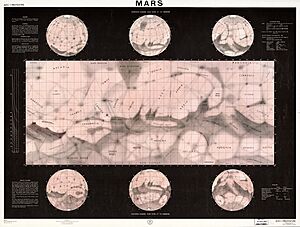
By the 1800s, telescopes were good enough to see features on Mars's surface. On September 5, 1877, Mars was very close to Earth. The Italian astronomer Giovanni Schiaparelli used a 22-centimetre (8.7 in) telescope to create the first detailed map of Mars. These maps famously showed features he called canali. This word means "channels" or "grooves," but it was wrongly translated in English as "canals." These canali were thought to be long, straight lines on Mars's surface, and he named them after famous rivers on Earth. Later, it was shown that these were just an optical illusion.
Influenced by these observations, an American named Percival Lowell built an observatory with large telescopes. He used it to study Mars in 1894 and later. He wrote several books about Mars and life there, which greatly influenced the public. Other astronomers also reported seeing the canali.
The idea that Mars had seasons (with polar caps shrinking and dark areas forming) combined with the "canals" led to many people believing there was life on Mars. They thought Mars had huge seas and plants. But as bigger telescopes were used, fewer long, straight canali were seen. In 1909, Antoniadi used a 84-centimetre (33 in) telescope and saw irregular patterns, but no canali.
Robotic Exploration
Many crewless spacecraft, including orbiters, landers, and rovers, have been sent to Mars. The Soviet Union, the United States, Europe, India, the United Arab Emirates, and China have all sent missions to study Mars's surface, climate, and geology. NASA's Mariner 4 was the first spacecraft to visit Mars. Launched on November 28, 1964, it flew closest to the planet on July 15, 1965. Mariner 4 found Mars's weak radiation belt and took the first close-up pictures of another planet from deep space.
Once spacecraft like NASA's Mariner missions (in the 1960s and 1970s) visited Mars, many old ideas about the planet changed completely. After the Viking experiments looking for life, most scientists agreed that Mars was a lifeless planet. Data from Mariner 9 and Viking helped create better maps of Mars. The Mars Global Surveyor mission (1996-2006) made very detailed maps of Mars's surface, magnetic field, and minerals. These maps are available online, for example, on Google Mars. Both the Mars Reconnaissance Orbiter and Mars Express continued exploring with new tools and supported lander missions. NASA offers two online tools: Mars Trek, which shows Mars using data from 50 years of exploration, and Experience Curiosity, which lets you explore Mars in 3-D with the Curiosity rover.
As of 2023[update], Mars has ten working spacecraft. Eight are orbiting Mars: 2001 Mars Odyssey, Mars Express, Mars Reconnaissance Orbiter, MAVEN, ExoMars Trace Gas Orbiter, the Hope orbiter, and the Tianwen-1 orbiter. Two are on the surface: the Mars Science Laboratory Curiosity rover and the Perseverance rover.
Future missions planned for Mars include:
- NASA's EscaPADE spacecraft, set to launch in late 2024.
- The Rosalind Franklin rover mission, which will search for signs of past life. It was supposed to launch in 2018 but has been delayed, with the earliest launch now in 2028. The project got new funding in 2024.
- A joint NASA-ESA mission to bring samples back from Mars is being planned for launch in 2026.
As of February 2024[update], over seven tons of debris from these missions have reached Mars. Most of this is made up of crashed or inactive spacecraft and discarded parts.
In April 2024, NASA chose several companies to start studying how to use commercial services to help robotic science on Mars. Key areas include setting up communication, delivering payloads, and imaging the surface.

Legend: Active (white lined, ※) • Inactive • Planned (dash lined, ⁂)
Could Life Exist on Mars?
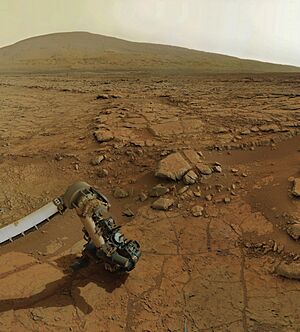
In the late 1800s, many astronomers thought Mars could support life, with oxygen and water. However, in 1894, W. W. Campbell at Lick Observatory found that if water vapor or oxygen were in Mars's atmosphere, there were too few to detect with the tools available then. This observation went against many measurements at the time and wasn't widely accepted. Campbell and V. M. Slipher repeated the study in 1909 with better instruments, getting the same results. It wasn't until W. S. Adams confirmed these findings in 1925 that the idea of Earth-like life on Mars was finally disproven. Still, even in the 1960s, some articles suggested Martian biology, explaining seasonal changes as life.
Today, scientists think that for a planet to support life, it needs liquid water on its surface. This usually means the planet must be in the "circumstellar habitable zone" around its star. For our Sun, this zone is thought to extend from Earth's orbit to about Mars's orbit. During its closest approach to the Sun, Mars enters this zone. However, Mars's thin atmosphere (low pressure) stops liquid water from existing over large areas for long periods. The past flow of liquid water shows that the planet once had the potential for life. Recent evidence suggests that any water on Mars's surface might have been too salty and acidic to support Earth-like life.
The conditions on Mars make it hard for living things to survive. The planet has little heat transfer across its surface. It also has poor protection against the solar wind because it lacks a magnetic field. Plus, its atmosphere isn't thick enough to keep water in liquid form (water instead turns directly into gas). Mars is almost, or completely, geologically dead. The end of volcanic activity seems to have stopped the recycling of chemicals and minerals between the surface and inside the planet.
Evidence suggests that Mars was once much more suitable for life than it is today. But whether living organisms ever existed there is still unknown. The Viking probes in the mid-1970s had experiments to find tiny living things in Martian soil. They got positive results, like a temporary increase in CO
2 when exposed to water and nutrients. However, scientists later debated if this was truly a sign of life. NASA scientist Gilbert Levin still believes Viking may have found life. A 2014 study of a Martian meteorite found chlorate, perchlorate, and nitrate ions in high amounts. This suggests they are common on Mars. UV and X-ray radiation would turn these ions into other very reactive chemicals. This means any organic molecules (building blocks of life) would need to be buried deep underground to survive.
Small amounts of methane and formaldehyde have been found by Mars orbiters. Both of these chemicals break down quickly in Mars's atmosphere. Their presence could be a sign of life. However, these compounds could also be produced by volcanoes or other geological processes, like serpentinite. Impact glass, formed when meteors hit the surface, can preserve signs of life on Earth. This type of glass has also been found in impact craters on Mars. So, if life existed at those sites, the glass might have preserved its signs.
Human Missions to Mars
Many plans for a human mission to Mars have been suggested over the years, but none have happened yet. The NASA Authorization Act of 2017 asked NASA to study sending humans to Mars in the early 2030s. The report concluded this would not be possible. In 2021, China also planned to send a crewed mission to Mars in 2033. Private companies like SpaceX have also proposed plans to send humans to Mars, with the goal of eventually settling on the planet. As of 2024[update], SpaceX is developing its Starship rocket for Mars colonization. Elon Musk, the head of SpaceX, hopes to start a Mars colony within the next twenty years. This would be possible by mass-producing Starship rockets. The colony would first rely on supplies from Earth, then use resources found on Mars, until it can support itself completely. Any future human mission to Mars will likely happen during the optimal Mars launch window, which opens every 26 months. The moon Phobos has even been suggested as a place to build a space elevator. Besides national space agencies and space companies, groups like the Mars Society and The Planetary Society also support human missions to Mars.
Mars in Popular Culture
Mars's dramatic red color and old scientific ideas about intelligent life there have inspired many stories. This led to many science fiction tales. One famous example is H. G. Wells' The War of the Worlds, published in 1898. In this book, Martians try to escape their dying planet by invading Earth.
Other important works include Ray Bradbury's The Martian Chronicles, where human explorers accidentally destroy a Martian civilization. There's also Edgar Rice Burroughs' Barsoom series, C. S. Lewis' novel Out of the Silent Planet (1938), and several Robert A. Heinlein stories.
Jonathan Swift wrote about the moons of Mars in his novel Gulliver's Travels. This was about 150 years before they were actually discovered by Asaph Hall. Swift even gave reasonably accurate descriptions of their orbits.
A funny Martian character, Marvin the Martian, first appeared in the Haredevil Hare (1948) animated cartoons by Warner Brothers. He is still a popular character today.
After the Mariner and Viking spacecraft sent back pictures of Mars, showing it as a seemingly lifeless world, these old ideas about Mars had to change. A new trend began for realistic stories about human colonies on Mars. The most famous of these might be Kim Stanley Robinson's Mars trilogy. However, theories about the Face on Mars and other mysterious landmarks seen by space probes mean that ancient civilizations are still a popular theme in science fiction, especially in movies.
Images for kids
-
Geologic map of Mars (USGS, 2014)
-
A cross-section of underground water ice is exposed at the steep slope that appears bright blue in this enhanced-color view from the MRO.
-
Viking 1 image of Olympus Mons. The volcano and related terrain are approximately 550 km (340 mi) across.
-
Valles Marineris, taken by the Viking 1 probe
-
Curiosity’s robotic arm showing drill in place, February 2013
-
Ingenuity helicopter on Mars, preparing for its first flight
See also
 In Spanish: Marte (planeta) para niños
In Spanish: Marte (planeta) para niños


